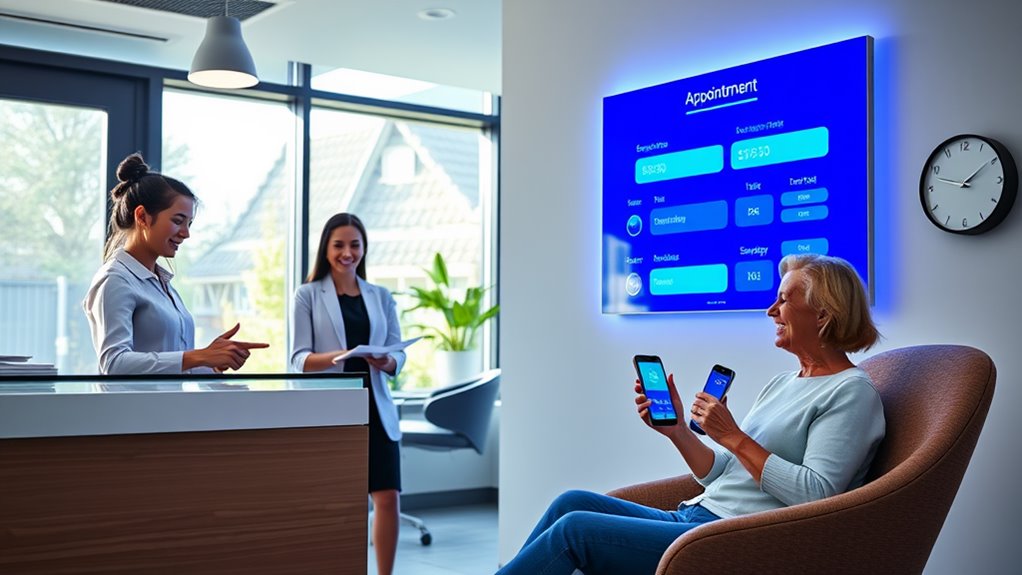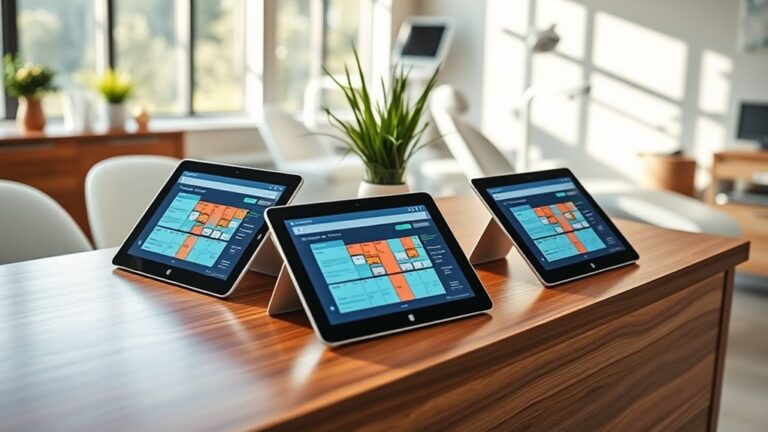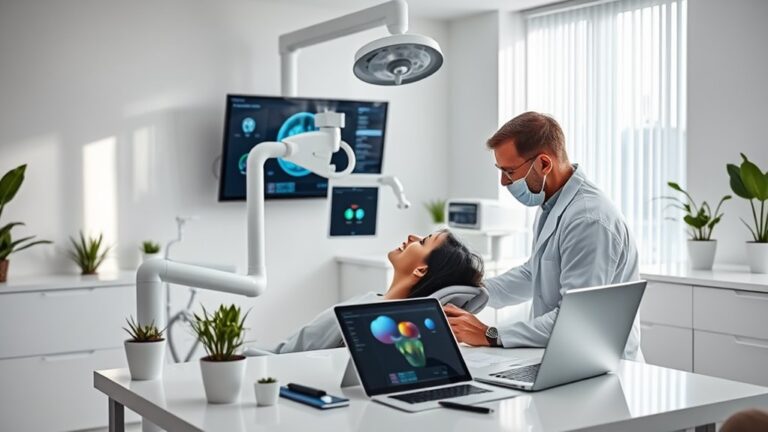5 Best Smart Solutions to Slash Dental Appointment No-Shows
Just like a ship lost at sea, dental practices can struggle to stay on course when faced with appointment no-shows. You've likely encountered the frustration of empty chairs and wasted time, but there are smart solutions that can help. By implementing effective strategies, you can substantially improve attendance and patient compliance. From automated reminders to scheduling efficiency, these methods can transform your practice's operations. If you're looking for assistance in navigating these solutions, feel free to contact us. We can connect you with experts who can provide tailored strategies to enhance your practice. So, how can you harness these solutions to create a smoother sailing experience for both you and your patients? Let's explore the top five approaches.
Automated Reminder Systems
Automated reminder systems are a game-changer for dental practices looking to reduce no-show rates. By implementing these systems, you can decrease no-show rates by up to 22.95%, resulting in a significant 41% drop in missed appointments.
This not only boosts patient compliance but also enhances staff efficiency, allowing your team to focus on more critical tasks like patient relations and marketing.
When patients receive reminders through their preferred communication methods—texts, emails, or phone calls—they're 25% less likely to forget appointments. This multi-channel approach guarantees maximum effectiveness and engagement, ultimately leading to fewer cancellations.
In fact, automated reminders can lead to an impressive increase in practice productivity, generating an incremental production of over $31,000 annually. Additionally, these systems can reduce no-shows by up to 90%, further amplifying the financial benefits for your practice.
Moreover, implementing these systems allows you to recover initial service costs within just six months. By reducing no-shows, you could save your practice hundreds of thousands of dollars each year.
With automated reminders, not only do you improve patient compliance, but you also create a streamlined workflow that enhances staff efficiency, making your practice more effective in serving the community.
Customizable Reminders
Leveraging customizable reminders can substantially enhance patient engagement and reduce no-show rates. By incorporating personalized messaging, you can include the patient's name, appointment date, and the practice's details, such as the doctor's name and practice contact information. This personal touch fosters a connection that encourages attendance.
You can also customize reminders to include specific instructions or preparations needed for their visit, making certain that patients arrive prepared. Use ready-made templates and merge fields to streamline this process, allowing you to maintain your practice's voice in automated communications.
Empowering patients with choice is vital. Offer them the option to select their preferred reminder channel—text, email, or phone call—and to receive additional reminders if they think they might forget. Allowing them to confirm or cancel appointments via response further enhances control and reduces last-minute cancellations.
Sending reminders at strategic intervals—like a week in advance and the day before—helps keep appointments top-of-mind. Additionally, automated reminders help streamline communication and effectively reduce no-shows.
Finally, integrating automated updates into your practice management system makes sure that patient responses are logged and managed efficiently, creating a seamless experience for both your team and your patients.
Multichannel Communication
Multichannel communication is essential for effectively reaching patients and minimizing dental no-shows. By using various channels like automated calls, text messages, and emails, you guarantee that reminders reach patients through their preferred communication method. This approach maximizes engagement and caters to diverse patient preferences and demographic targeting, enhancing overall satisfaction.
For instance, younger patients often prefer text reminders, while others may respond better to emails. A national survey revealed that 55% of respondents favored text message appointment reminders. Additionally, automated reminders can significantly cut down no-show rates, with some practices experiencing a reduction by up to 20%.
Personalizing these communications—addressing patients by name and including specific appointment details—can substantially boost engagement. Allowing patients to customize their reminder preferences further enriches their experience and makes them feel valued.
Timing also plays a crucial role; sending reminders a week in advance helps patients plan, reducing last-minute cancellations. Integrating automated reminder systems with your practice management software increases efficiency, allowing for consistent and timely notifications.
Organizational Change Models
Effective communication strategies can set the stage for broader changes within your dental practice. By implementing organizational change models, you can effectively manage change and enhance stakeholder engagement, ultimately reducing appointment no-shows.
The Prosci ADKAR model emphasizes the importance of raising awareness about the need for change and fostering a desire among your team to embrace it. Sharing success stories can motivate staff, while training provides the knowledge and ability to adopt new practices. Reinforcing these changes through positive feedback helps solidify their acceptance.
The McKinsey 7-S model aligns your change initiatives with your practice's strategy, adjusting structures and systems to support new processes. Securing shared values and developing necessary skills among staff are essential for successful implementation. This process of change management ensures that quality and integrity are maintained throughout the transition.
Using Lewin's model, prepare your team for change by addressing resistance, providing support during implementation, and solidifying new behaviors.
Lastly, Lukas et al.'s model highlights the importance of stakeholder engagement, involving everyone from patients to administrators in the change process. By monitoring and evaluating changes, you guarantee your initiatives effectively meet their goals, creating a more efficient dental practice.
Scheduling Efficiency
Efficient scheduling is essential for minimizing dental no-shows and maximizing the use of your practice's time. By implementing smart scheduling strategies, you can streamline your workflow and enhance patient engagement. Here are three key methods to take into account:
- Automated Reminders: Send timely reminders through patients' preferred communication methods to reduce forgetfulness.
- Block Scheduling: Organize your day into time blocks for specific procedures, balancing workload and energy levels.
- Two-Way Communication: Enable patients to confirm, cancel, or reschedule appointments easily.
Using block scheduling can help you manage time effectively. Analyze the duration of procedures to create a realistic schedule, eliminating gaps that can lead to inefficiencies. Additionally, ensure that you give appointments enough time by accurately estimating treatment durations and including buffer time for unexpected events.
Prioritize more complex procedures earlier in the day, and include buffer time between appointments to keep the flow smooth.
This approach ensures that you make the most of your time and resources, minimizing disruptions and optimizing patient care throughout the day.
Frequently Asked Questions
How Can We Measure the Impact of Reminder Systems on Patient Behavior?
You can measure the impact of reminder systems on patient behavior through data analysis and metric tracking. Monitor no-show rates, cancellation statistics, and patient feedback to evaluate effectiveness and enhance appointment adherence strategies.
What Are the Best Practices for Personalizing Appointment Reminders?
Think of how a warm greeting makes you feel special. Use personalized greetings and tailored messaging in appointment reminders, including specific details and patient preferences, to enhance engagement and guarantee a memorable experience for everyone involved.
How Do Automated Reminders Affect Patient Trust and Relationship With the Practice?
Automated reminders enhance trust building by demonstrating your commitment to patient engagement. These consistent, personalized communications make patients feel valued, reinforcing their connection to your practice and encouraging a loyal, trusting relationship over time.
What Are Common Barriers to Implementing Reminder Systems in Dental Practices?
You'll face common barriers like data accuracy issues, patient comprehension challenges, reminder timing discrepancies, and contact method limitations. Additionally, demographic challenges can hinder effective communication and technology adoption, affecting overall reminder system success in dental practices.
How Can We Train Staff to Effectively Use Reminder Systems?
Training staff to master reminder systems isn't rocket science; it's like teaching a cat to chase a laser pointer! Focus on user adoption, customize messages, and monitor effectiveness to elevate patient engagement and satisfaction.
Conclusion
Incorporating these smart solutions can substantially reduce dental appointment no-shows, and we're here to help you implement them effectively. For instance, practices that have adopted automated reminder systems have reported a remarkable drop in no-show rates by as much as 20%. By customizing reminders, utilizing multichannel communication, and optimizing scheduling, you can significantly enhance patient compliance and streamline your operations.
Reaching out for expert assistance can save you valuable time, reduce stress, and ultimately improve your dental practice's efficiency. Embracing these strategies not only enhances the patient experience but also allows you to focus more on providing quality care. Don't let no-shows hold you back—contact us today to explore how we can support you in overcoming these challenges!





